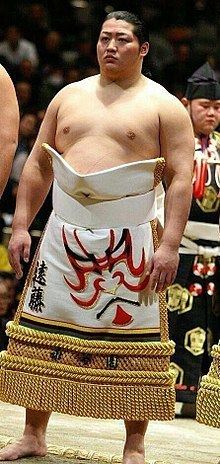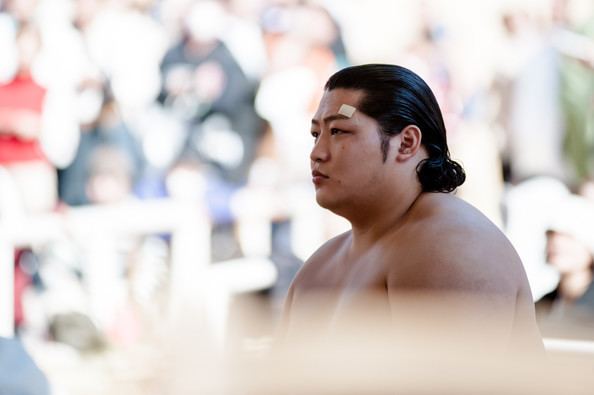Debut March, 2013 Special Prizes Fighting Spirit (1) Role Sumo Wrestler Weight 143 kg | Current rank see below Championships 1 (Juryo) Name Endo Shota Height 1.86 m | |
 | ||
Highest rank Maegashira 1 (March, 2014) Similar People Osunaarashi Kintaro, Ichinojo Takashi, Terunofuji Haruo, Kisenosato Yutaka, Hakuho Sho | ||
Endō Shōta (遠藤 聖大), (born October 19, 1990) is a professional sumo wrestler from Ishikawa Prefecture, Japan. After a successful amateur career, he turned professional in March 2013, making the top makuuchi division that September. His highest rank has been maegashira 1, and he has two special prizes for Fighting Spirit and Technique, and two gold stars for defeating yokozuna. He was runner-up in the September 2016 tournament. He wrestles for Oitekaze stable. He is extremely popular with Japanese sumo fans and has been regarded as one of the most promising home-grown wrestlers in sumo.
Contents
Early life and sumo background

Endō first began trying out sumo in his primary school years largely to please his father. He did not like sumo at first, but as time went on he became inspired by the spirit and technique of then yokozuna Asashōryū. He began trying out more techniques and came to love sumo. In his second year of junior high school, he participated in a Kanazawa area sumo competition, where he won the team championship as well as beating the future Tochinosato in a playoff to take the individual championship. In high school, he participated in several team and individual competitions, taking two separate championships. Upon graduation he entered Nihon University as an economics major. From his fourth year he was captain of the sumo team. That year he also took two major national championship titles becoming both the amateur sumo yokozuna as well as the National Athletic Championship yokozuna. Despite of his great success at sumo thus far, it was a difficult decision for Endō whether or not to go professional, because he had a dream of becoming a teacher.
Career
After taking some time to reflect he decided to join professional sumo as a wrestler for Oitekaze stable, the stable where Daishōyama, who was from the same hometown as him, was the founder and head coach. Upon entering professional sumo he was allowed to debut as a makushita tsukedashi instead of starting at the bottom of the ranks, to reflect his amateur success. Moreover, because of his two national championships he was allowed to debut at an even higher rank than other amateur champions. This debut at makushita 10, was only the second time this has had been allowed, following his Nihon University predecessor Ichihara. He entered the professional ring in the March 2013 tournament, choosing to keep his surname of Endō as his shikona. He was not quite as successful as was expected, managing two consecutive tournaments with strong, but less than ideal, 5-2 records. They were enough, however, to allow him to join the salaried ranks of jūryō for the July 2013 tournament. He did so without a top-knot as his hair was still not long enough for one. Debuting at the rank of jūryō 13, he came into his own, finally giving the kind of performance that had been expected of him. He beat several wrestlers with top makuuchi division experience as well as other up and comers, including the closely watched Egyptian wrestler Ōsunaarashi. His only loss was to jūryō regular Tokushinhō. His 14-1 record was at least a four win berth over any other wrestler in the division and his championship was already decided by the 13th day of the tournament. His previous amateur success, his technique and his seemingly effortless championship fueled speculation that Endō could be the next big Japanese hope in professional sumo in a sport largely dominated by foreigners in the higher ranks.
His success continued into his makuuchi debut in September 2013, where he scored a majority of wins, although he damaged his left ankle and dropped out of the tournament on Day 14. After making a respectable comeback in November with a score of 6–9 from the rank of maegashira 7, he had his best result in the top division to date in January 2014, winning eleven bouts and the Fighting Spirit Prize. He was even matched with an ōzeki, Kotoshōgiku, on Day 12, although he lost this bout. Promoted to the top of the maegashira ranks for the March 2014 tournament, he faced three ōzeki and two yokozuna in his first five matches. He lost the first four but defeated Kisenosato on Day 5, his first win over an ōzeki, and the fact that he was still without a top-knot was also noted. He finished the tournament with a 6-9. The following May 2014 tournament, while only managing a 7-8, he got his first gold star win against yokozuna Kakuryū.
Endō suffered a serious injury to his left knee in the March 2015 tournament, rupturing anterior cruciate ligaments. He opted not to have surgery and competed in the following tournament in May, knowing he would be demoted to jūryō if he failed to take part. Although he only scored six wins against nine losses, it was enough to keep him in the top division. In the Nagoya tournament in July, he came through with a solid 10-5 record and recorded 8 wins in September. A disappointing 4-11 in November however, was followed by an injury in the January 2016 tournament and Endō was demoted to the second division (jūryō) for March. He returned to the top division in May 2016 and scored 11–4, although a defeat on the final day meant he missed out on a share of the Fighting Spirit prize. In September 2016, fighting from the low rank of maegashira 14, he finished runner-up to Goeido on 13–2 and won his first Technique Prize. In November he defeated three ozeki and yokozuna Hakuho but lost four of his last five matches to finish with a make-koshi 7-8 record, which cost him the Outstanding Performance Award.
Fighting style
Endō is a yotsu-sumo wrestler, preferring grappling techniques to pushing and thrusting. His most common winning kimarite is a straightforward yori kiri, or force out, and he uses a hidari yotsu grip on the mawashi or belt, with his right hand outside and left hand inside his opponent's arms.
